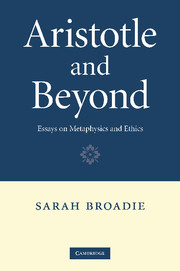Book contents
- Frontmatter
- Contents
- Preface
- Acknowledgments
- Chapter 1 Affecting and being affected
- Chapter 2 Backwards causation and continuing
- Chapter 3 From necessity to fate: An inevitable step?
- Chapter 4 Alternative world-histories
- Chapter 5 A contemporary look at Aristotle's changing Now
- Chapter 6 Nature and craft in Aristotelian teleology
- Chapter 7 Soul and body in Plato and Descartes
- Chapter 8 Aristotle and contemporary ethics
- Chapter 9 On the idea of the summum bonum
- Chapter 10 What should we mean by ‘the highest good’?
- Chapter 11 The good of practical beings: Aristotelian perspectives
- Chapter 12 Taking stock of leisure
- References
- Index of names
Chapter 1 - Affecting and being affected
Published online by Cambridge University Press: 25 June 2009
- Frontmatter
- Contents
- Preface
- Acknowledgments
- Chapter 1 Affecting and being affected
- Chapter 2 Backwards causation and continuing
- Chapter 3 From necessity to fate: An inevitable step?
- Chapter 4 Alternative world-histories
- Chapter 5 A contemporary look at Aristotle's changing Now
- Chapter 6 Nature and craft in Aristotelian teleology
- Chapter 7 Soul and body in Plato and Descartes
- Chapter 8 Aristotle and contemporary ethics
- Chapter 9 On the idea of the summum bonum
- Chapter 10 What should we mean by ‘the highest good’?
- Chapter 11 The good of practical beings: Aristotelian perspectives
- Chapter 12 Taking stock of leisure
- References
- Index of names
Summary
INTRODUCTION
What is it for one thing to affect or to act on another? Examples come to mind: bending a bar of iron, moving a ball, melting wax. But there are other relationships one can have with an iron bar: one can also look at it, think about it, want it, approach it. Are not these too kinds of doing to it? We might say: even thinking about something is treating it in a certain way. Yet we should hardly admit that thought, sight, desire, and approaching affect or act on their objects. If we want to say that these are ways of treating things, then we have to say that not all cases of treating things are cases of affecting them. To put it in the formal mode: not every transitive verb ‘φ’, i.e. not every verb ‘φ’ with active and passive voices, is such that ‘x φs y’ entails ‘x acts on or affects y’. Let us call the values of ‘φ’ for which this entailment does hold, affective verbs, and those for which it does not, non-affective. Now the question of this paper is: what are the logical characteristics of affective, as opposed to non-affective, verbs? Or to put it in the material mode, using the term ‘operation’ neutrally: what are the logical characteristics of affective as opposed to non-affective operations?
- Type
- Chapter
- Information
- Aristotle and BeyondEssays on Metaphysics and Ethics, pp. 1 - 17Publisher: Cambridge University PressPrint publication year: 2007
- 1
- Cited by



